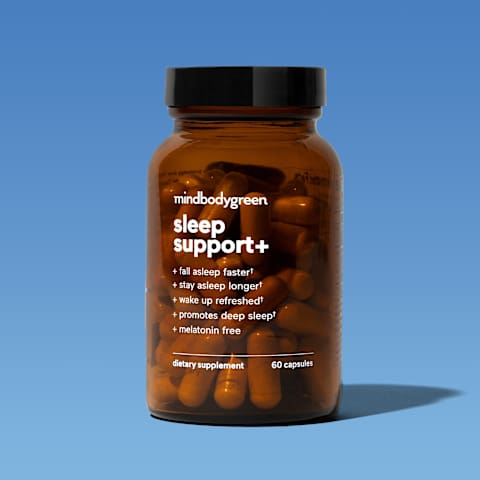Advertisement
New Research Shows That School Mindfulness Training Can Help Improve Kids' Sleep


It's easy to assume that kids "sleep like babies" well into adolescence. A study that will soon be printed in the Journal of Clinical Sleep Medicine found that this isn't necessarily true: Children—particularly those who live in lower socioeconomic status households—face some of the same barriers to sleep as adults. But, thankfully, free tools exist to help all of us rest a little easier.
Teaching mindfulness in schools.
This study monitored 115 children ages 8 to 11 over two years. Twice per week, half of them went through a mindfulness curriculum of breathing exercises and yoga-based movement skills. The other half attended a more typical physical education class instead. All of the students—a mix of boys and girls—lived in communities of low socioeconomic status (SES).
Christina F. Chick, Ph.D., a lead researcher on the study from Stanford University, tells mindbodygreen that the team chose to focus on kids living in low-SES environments because they are, unfortunately, more likely to experience short sleep duration and poor sleep quality.
The reasons for this are manifold: "They are likely to live in neighborhoods with a higher density of residents, which might mean more noise or light during the sleep period," explains Chick. "Another reason is logistical: Families with fewer financial resources are more likely to have multiple people sleeping in the same room. If a child shares a bedroom with an older kid who goes to bed later, or with a parent who wakes up earlier to go to work, then the lights go off later and turn on earlier, making it more difficult to get consolidated sleep."
Finally, she says, when parents are carrying excess stress, it can trickle down to kids, too: "Children may not know the details of the situation—for example, which bills are due, or what's going on at the parent's job—but they certainly understand when parents are stressed, and they sometimes take that on as their own."
Over the course of this study, the children's sleep quality and perceived social stress were measured three times: once prior to their mindfulness or P.E. class, and twice at yearly follow-ups.
How the classes affected sleep.
The children who received the mindfulness training showed significant improvements in sleep length and quality: On average, they gained 74 minutes of total sleep time and 24 minutes of rapid eye movement (REM) sleep per night over the two years.
The children who took P.E. experienced a decrease in total sleep time over the course of the study and didn't have changes in their REM sleep.
Perhaps the most interesting result of this study—and the most surprising to Chick—was that while the children who received mindfulness training slept better, they didn't report stressing any less. In fact, the kids whose sleep improved the most (usually the ones who practiced their new mindful skills outside the classroom) experienced increases in perceived social stress.
"What this tells me is that they were able to implement the skills that they learned in the curriculum to calm down their nervous system, even when they were stressed," says Chick. It also suggests that these new mindfulness skills helped kids better identify when they were going through periods of high stress—without necessarily feeling weighed down by them.
"My takeaway is that, even when we can't control the amount of stress in our life, we can still affect how our body responds to that stress, which has measurable effects on our sleep and, presumably, other aspects of our health," adds Chick.
What this research means for kids and parents.
This study demonstrates that it's never too early to start teaching kids age-appropriate mindfulness skills. (You can access the "Pure Power" curriculum used in it here.) Chick suspects that doing so before the challenges of adolescence arise can give kids a leg up on healthy stress management skills before they really start needing to put them to the test.
"If kids start practicing mindfulness, including mindful breathing and movement before they enter a more stressful period of life," she says, "that gives them an opportunity to build a habit so that it becomes second nature to use these techniques when they are stressed, and they don't even have to think about it."
And if you're a parent looking to teach mindfulness to your kids, there's no better way than leading by example. Chick says that telling your child when you're feeling stressed or tense, and taking a moment to close your eyes and breathe deeply, can set a powerful example for them.
Practicing accessible breathing or yoga techniques together—like deep breathing or an extended exhale—can prove beneficial for both of you.
"No matter our age, we all get stressed, and we all have the opportunity to take an active role in managing our body's response to stress by using these techniques," says Chick.
The bottom line.
Mindful adults will know that taking a moment to connect to the breath and body can relieve stress during the day and lead to uninterrupted sleep at night. This new research suggests that the same is true for kids, particularly those who have a lot on their plate. Consider this your cue to kick off family "breathing breaks" and reconnect with yourselves, together.
